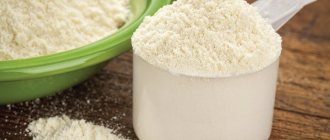Creatine is a nitrogen-containing carboxylic acid that is involved in energy metabolism in nerve and muscle cells. Its main beneficial effect is to supply muscles with energy during high-intensity training, including strength training and sprinting.
The effect is due to the fact that in muscles creatine binds with phosphorus to form phosphocreatine. Increasing the latter by about 20% helps the body withstand extreme loads longer and recover faster between approaches. As a result, the athlete becomes more productive and can better perform repetitive exercises during training. This helps increase strength and enhance muscle growth.
Creatine monohydrate is the most common in sports nutrition, but this supplement has 14 other chemical forms. Each has its own characteristics and recommendations for use. Therefore, in order to decide which creatine is best to buy, you should first familiarize yourself with all the forms that exist.
We advise you to study: “How to take creatine correctly.”
Creatine monohydrate
When considering the question of which type of creatine is better to choose, we can say with certainty - monohydrate. Even if you are not sure, you can't go wrong with this form. Monohydrate is the most studied and inexpensive. In addition to creatine, such supplements also contain 12% water. Very fine grinding ensures almost complete dissolution and best absorption.
If we talk about which creatine monohydrate is better, we can cite the following supplements:
- Creatine Drive Black from Nutrex (USA).
- Creatine Monohydrate from Be First (Russia).
- Performance Creatine from San (USA).
- Creatine 6000 from FIT-RX (Russia).
- Creatine from Maxler (Germany).
Creatine and endurance sports
To date, a fairly small number of studies have been conducted on the effect of creatine on the endurance of athletes, which also give conflicting results.
The main side effect associated with creatine use is weight gain. And if this is not so critical for rowers, then increasing the weight for a marathon runner or cyclist, even by half a kilogram, can significantly affect their results.
However, this does not mean that creatine cannot benefit endurance athletes. Some studies suggest that taking creatine may provide indirect benefits for runners, cyclists and triathletes, such as performing anaerobic finishes or passing an opponent. In addition, with the help of creatine, athletes can perform harder and more intense workouts during the preparatory period.
A study published in the journal Medicine & Science in Sports & Exercise in 1998 1 examined the effects of low doses of creatine (6g per day) on the performance of athletes. For this purpose, a special test was created for triathletes, which combined endurance and interval loads. After completing it, the athletes took 6 g of creatine daily, divided into two parts for 5 days. On the 6th day a control test was carried out.
Based on the results, it was found that taking creatine did not affect the cardiovascular system, oxygen absorption and blood lactate concentration . And although power during interval training increased by 18%, this did not affect endurance in any way.
The following study2 found that creatine supplementation decreased recovery time from short intense intervals (15 seconds) and increased peak power in athletes.
Another study examined the effects of creatine on aerobic performance and anaerobic capacity of elite rowers during endurance training3.
Sixteen rowers were divided into two groups: the first group received 20g of creatine monohydrate for 5 days, the second received a placebo.
The results of the study showed that those rowers who took creatine had improved endurance (as reflected by an increase in individual TRAN) and anaerobic performance, regardless of the effect of intense endurance training.
In addition, some studies4,5 have noted that creatine use leads to improved thermoregulation of the body, which may affect the performance of endurance athletes.
There is also evidence9 that associates creatine supplementation with increased muscle glycogen storage after endurance exercise.
The International Association of Athletics Federations (IAAF) notes in its review of sports supplements that creatine use may negatively impact the performance of endurance athletes.
Creatine citrate
Once monohydrate became popular, another form of creatine appeared on the market - citrate. Its main difference was citric acid. During the production process, its molecules are attached to creatine molecules. The goal is to increase the amount of energy produced by creatine. This is achieved due to the fact that citric acid participates in the tricarboxylic acid cycle (Krebs cycle), and its result is always the production of adenosine triphosphate (ATP), a source of energy for the body. Compared to monohydrate, citrate is also slightly more soluble in water.
Role of Creatine in Energy Production
The primary source of energy in the body is the compound ATP, or adenosine triphosphate. ATP is a chemical compound containing bonds that, when hydrolyzed, release large amounts of energy. The body is able to produce ATP on its own, but during intense training it simply does not have time to synthesize it in sufficient quantities.
ATP, releasing energy, loses one of its phosphate molecules, turning into ADP (adenosine diphosphate), which is unable to produce energy. To produce energy, ADP must receive one phosphate molecule, after which it becomes ATP again. In the body, creatine is present in the form of creatine phosphate, which sacrifices its phosphate molecule to form ATP, thereby facilitating the release of energy.
By taking additional creatine, you can significantly increase your energy reserves during intense workouts, making them more fruitful!
With creatine you will get:
- Increased muscle strength;
- Reduced sensations of muscle fatigue;
- Accelerated recovery;
- Increased muscle endurance;
- High-quality hydration.
Creatine hydrochloride
One of the latest developments in sports nutrition is creatine hydrochloride. This form is obtained by attaching a hydrochloride group to creatine to form the corresponding salt. In medicine, a similar simple method is used to increase the bioavailability and effectiveness of active ingredients. The hydrochloride has:
- improved solubility;
- increased bioavailability (more effective at lower dosages, has fewer side effects and does not put a strain on the liver and kidneys);
- accelerated absorption (muscles receive nutrients faster).
According to some studies, the hydrochloride form combines better with caffeine, which is why it is often included in pre-workout supplements.
We recommend studying: “How to take caffeine to improve athletic performance and lose weight.”
Which creatine is better - monohydrate or hydrochloride? For those who have digestive problems or allergies from monohydrate, it is better to choose hydrochloride. It does not cause bloating or digestive upset, and also provides the maximum benefits of a supplement such as creatine.
The Role of Creatine in Recovery and Muscle Growth
Creatine helps accelerate the recovery process of muscle tissue and also delays the formation of lactic acid. During intense training, glycogen breaks down, resulting in the formation of lactic acid. Creatine phosphate in such cases acts as its buffer.
Creatine also promotes hydration of muscle cells as a prerequisite for muscle protein synthesis, forming new muscle fibers. But qualitative growth of muscle mass is impossible without new muscle tissue.
Other Forms of Creatine
Micronized Creatine
. Regular monohydrate, but subjected to a micronization process. In such an additive, the particle size of the powder is 20 times smaller than in a regular one, and this ensures faster dissolution and better absorption by the body. If we consider which creatine is the most effective, then we can say that micronized.
Creatine tartrate.
Does not have any special advantages over monohydrate. The main advantage is that it retains its properties longer, which is due to the presence of tartaric acid in the composition, which is often used in the manufacture of chewable lozenges, effervescent and regular tablets, and capsules.
Magnesium creatine.
Magnesium molecules in the supplement improve its absorption, since it is involved in the process of converting creatine phosphate into ATP.
We advise you to study: “What are the benefits of magnesium for athletes: differences from magnesium B6 and rules of administration.”
Creatine-glutamine-taurine.
A combination of three substances: creatine, glutamine and taurine. The combination was not chosen by chance, but on the basis that glutamine and creatine, together with taurine, will enter the muscles faster and be retained in them longer.
Buffered creatine.
It is considered safer and more effective compared to monohydrate. Its peculiarity is that it matches the pH level in the stomach. This allows creatine to not be broken down into creatinine, which increases the nutritional value of the supplement.
Creatine HMB.
Quite a new product on the market, but already has positive reviews. It contains creatine and HMB (beta-hydroxy beta-methylburate), which, after entering the body, are separated and absorbed separately. Among all types of creatine, this is the safest and does not have any effect on the stomach.
Creatine ester.
High-tech product with increased biological value. Taking this supplement dramatically increases the positive effects of creatine on the body. This is due to the fact that the attached ester group facilitates the passage of acid through the walls of intestinal cells and muscles.
Creatine in effervescent tablets (effervescent creatine).
A form with improved absorption, which is achieved due to the presence of citric acid and bicarbonate in the composition. When mixed with water, creatine separates from other components in the tablet and is absorbed in its pure form.
Creatine titrate.
The titrate provides better dissolution in water, but unlike effervescent tablets, it does not have an effervescent effect. The action is ensured by the fact that during the process of stirring the additive, the titrate affects hydrogen ions. Although there are no supporting facts, it is believed that this way the substance will be better absorbed.
Don't miss interesting news and events in the telegram channel: https://tlgg.ru/fitbarnews
Creatine – helps in exhausting, difficult workouts in overcoming barriers
Creatine is a nitrogen-containing compound that can constantly replenish muscles with energy during intense training, making it possible to overcome all possible and impossible limits in gaining muscle mass. Creatine supports the growth of muscle tissue and accelerates its recovery.
95 percent of the creatine contained in the human body comes from muscle tissue. As for food, it is found in beef, tuna, salmon, herring, and milk. If you are focused on muscle growth, you simply need to introduce creatine-containing products into your diet. However, it is worth noting that today sports nutrition manufacturers have made creatine as accessible as possible, offering a wide selection of supplements based on it.
Loading method of use
We recommend following certain rules for taking the supplement.
- Loading time is one week and three days. (10 days).
- The first week you will have to control the dose, since it is correct to take creatine at the rate of 0.25-0.30 g per 1 kg of body weight. Which, translated into normal language, means the daily requirement is 20 g for an 80-kilogram athlete.
- This mass should be divided into 4 teaspoons per day.
- The first dose is after waking up on an empty stomach, and the rest during the day.
- On days when training takes place, creatine should be taken immediately after exercise, because it is at this moment that the body needs immediate resuscitation.
- During this (loading) period, the concentration of the drug in the athlete’s body is highest. This may be enough for training before the start of competitions, tournaments and a new, difficult training program.
- If there is still a need to maintain the level of the substance in the body, then do not stop taking it, but reduce the dose. To calculate the maintenance dose of the drug, simply multiply your body weight by 0.03. For example 100 kg. the athlete takes 3 g.
- Take a 2-4 week break. At this time, the content of the substance returns to its original norm.
- There is an opinion that with normal consumption of natural creatine with food (meat, fish, animal products), the second maintenance period should be excluded. In this case, the active loading period can be repeated every few months.
How creatine works
Your body cannot use proteins, carbohydrates and fats in their original state. For normal functioning, substances are digested into the energy-containing molecule ATP. When creatine is present in the body, these ATP “energizers” are consumed less and their regeneration is accelerated. Creatine phosphate successfully fights acids formed in tissues during training (the so-called “krepatura”).
This allows athletes to stay alert longer and relieve muscle fatigue. The product promotes muscle growth, as the amount of subcutaneous fluid stored in the sarcoplasm increases. Approximate weight gain can be 4-5 kilograms per course. And perhaps, the expansion of muscles and the leveling of pain in the body after training are the most significant advantages of this drug.
The effect of taking creatine
Creatine monohydrate is considered by some athletes as an additional source of energy. But it is not only this promised result that seduces men.
- Muscle strength increases. Your body will choose synthesized creatine as a source of quick energy during strength exercises. This way you will save your own ATP and muscle glycogen. In total, you will see an increase in working weights and strength indicators.
- Volume growth. Roundness in the muscles appears due to the systematic accumulation of the drug in the body and retention of fluid in the tissues. The feeling of “expanding” is very pleasant for many athletes. A kind of swelling appears. As soon as you stop taking the product, the attractive forms will melt a little.
- Increasing the rate of muscle growth. Sarcoplasm - the nutrient medium around muscle tissue from creatine consumption improves its own quality. Sufficient glycogen + building elements = tissue growth.
- Reviews say that if you take creatine, testosterone levels go through the roof. According to clinical studies, its growth is approximately 22% per course. And all because creatin is similar in structure to testosterone.
Mechanism of operation
To understand the reasons for the popularity of a substance, it is worth understanding the mechanism of its action on the body. In the same scientific way, it was found that creatine works in several ways:
- With an increase in the volume of creatine phosphate in the skeleton, reserves appear for high-intensity work. This is true when it comes to intense loads with minimal rest periods.
- An increase in creatine phosphate leads to maintaining muscle tension for a long time. Thanks to this effect, not only an increase in muscle mass occurs, but also an increase in strength.
- Consistent intake of creatine supplements guarantees the activation of cellular homeostasis. As a result, the pH level is maintained at an optimal level.
- A decrease in creatine phosphate in the body (in its cells) leads to an increase in the volume of ADP. This action promotes rephosphorylation and an increase in the rate of glycolysis.
Creatine accelerates the growth of strength and muscles, optimizes recovery processes, and makes the body more efficient. Additionally, informal studies were conducted that showed that if the rest time between sets was reduced, the number of working repetitions also decreased. In addition, the increase in performance was not as noticeable in those athletes who rested 3-4 minutes before each approach. This fact confirms that if the supplement leads to an increase in endurance, it is only indirectly.
Creatine and potential health risks
Creatine is one of the most popular sports supplements in the world today, and it is not surprising that many people have a question - can creatine be harmful to health?
Scientific data shows that the chances of this happening are minimal. The IAAF, in the previously mentioned review, states that when used correctly and in proper dosages, creatine does not cause any negative health effects, even with very long-term use (more than 4 years).
This theory is confirmed by scientific research. The following scientific review10 examined the potential side effects of creatine supplementation on gastrointestinal, cardiovascular, musculoskeletal, renal, and hepatic function. The results did not find conclusive evidence linking creatine to a decline in these functions. The only documented side effect was weight gain. Moreover, scientists have found that in healthy people, even long-term use of creatine can be considered an effective and safe way to improve their performance.
Other studies11,12 also note that there are no side effects of creatine supplementation (other than weight gain), in particular a negative effect on the kidneys. However, scientists do not recommend taking large doses of creatine (more than 3-5 g/day) for people with pre-existing kidney disease or a potential risk of kidney dysfunction.
Does creatine promote weight gain?
Short-term studies show that creatine increases body weight, especially when following a loading protocol.4 This is most likely due to water retention
in muscle cells. In this case, this is actually a good sign because it shows that your body's creatine stores are increasing, which will lead to improved performance.
In the long term, weight gain is likely to occur due to increased lean muscle mass.1 Maximum creatine supply will improve performance (increasing sets and reps) and recovery. As a result, the quality of your training will improve, and ultimately you will increase lean muscle mass, which is what you need!
Application in sports nutrition
The Con-Cret supplement is produced by ProMeraSports. Now this dietary supplement retains its position as the sales leader in the creatine hydrochloride market. It is believed that this chemical type of substance has the greatest solubility, which means maximum digestibility and effect on the body.
The powder is used to increase energy reserves during intense physical activity. This effect prevents the launch of catabolic reactions and accelerates the growth of muscle fibers.
The compound neutralizes the formed acids during active cellular metabolism, which lower the pH of the blood. A shift in acid-base balance causes muscle fatigue.
The effect of creatine eliminates discomfort and increases endurance.
The supplement is used by athletes for more efficient absorption of glucose.
Which type of creatine to choose
According to the production method, the supplement is available in the form of capsules with a gelatin shell and in powder. Which type to choose for yourself depends on the personal preferences of the athlete. There are now several supplement options. The option “with a transport system” (creatine with additives to improve its properties and nourish muscles) is a successful marketing ploy, because the complex composition hides the same monohydrate, but with added vitamins. There is no particular difference between different types of the drug; the effect and accumulation system are the same for each of them. Slick traders try to sell naive beginners “advanced” supplements, but the effect of such miracle supplements is not superior to their cheap analogues. The sports supplement creatine can be bought at a pharmacy or in stores that sell sports nutrition “for mere pennies.”











